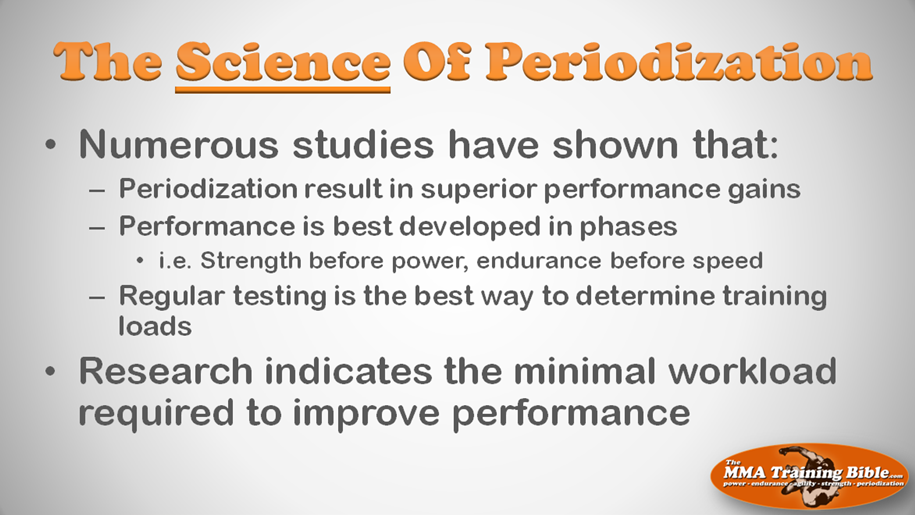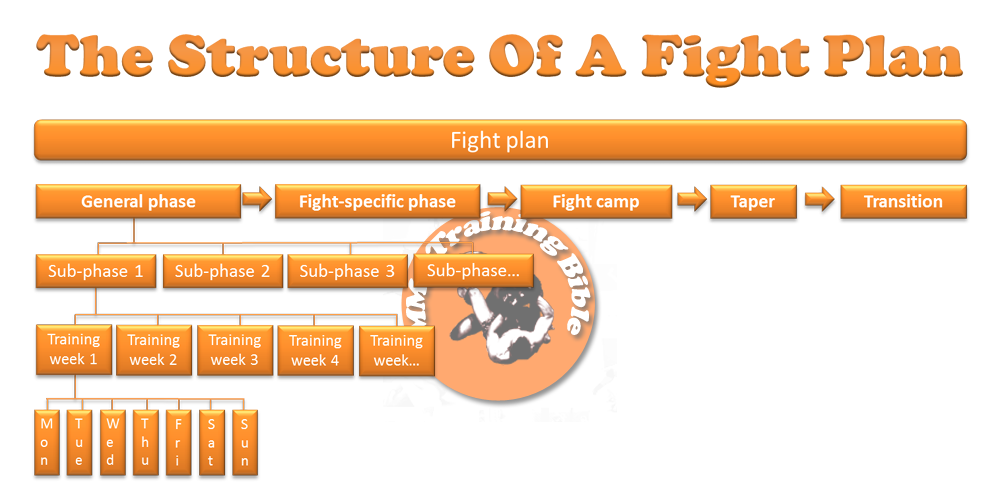Welcome to The MMA Training Bible’s Guide to periodization. In this article series you will learn about what is perhaps the most important aspect of your entire training plan: Periodization. You’ll learn how to structure (or periodize) your training plan over any length of time and get the most out of your effort. This will help you manage your fatigue on a daily, weekly and monthly basis, which will reduce your potential for overtraining, and optimize your performance in the cage.
In this article series you will learn about the most essential training theories that you need to know; the training effect, periodization theory. And I’m gonna teach you how to use this information to periodize your training for MMA, and I truly feel that if you take this information on board you will walk away with a crystal clear picture of how your training plan should be organised. You’ll be able to take control of your fight plan, and you’ll be supported by the latest scientific research.
On the other hand, if you pass over this material and you don’t learn the essential theories that are the foundation of your training plan and your success as a fighter, I think that you will waste some time, some energy, and maybe even some money doing the wrong type of training; or worse, I’ve actually seen some fighters burn-out, or give up and quit, or get injured after following inappropriately designed training plans.
So, if you don’t want to realize your full potential as a fighter, you don’t want to optimize your performance in the cage, or you don’t want to learn how to take control of your training plan, then just avoid learning about periodization, and don’t read this article series.
So, why learn periodization theory? To succeed in MMA, you need to know what to do (i.e. endurance, resistance, agility, skill training, flexibility) and you need to know how and when to do it. You need to know the steps to take to organize your entire fight plan. You need to know when you should train hard to ensure that you adapt and grow stronger, but you also need to know when you should have a rest day, or a rest week, to avoid overtraining and burn-out.
To know what do and when to do it, you need to understand periodization i.e. how the objectives of a training session should fit in with the objective of a training week, which fall in line with the objectives of the overall fight plan at that particular phase of training.
To understand how to organize your training, you must first understand periodization theory, which considers how you respond to a particular type of workout (training effect), and how the volume and intensity of training should change to meet your needs over your entire fight plan, and over your whole fight career (periodization theory).
You need to understand how your body responds to training, so that you can use the right training loads at the right time, and this needs to match up with your fight schedule, so that you can build yourself up to your highest level of preparedness, and peak for your fight.
This article series will be divided into 5 parts:
Part 1: Periodization demystified: you learned that periodization is an art, but it’s also a science. You also learned that there are a number of ways that your performance can improve by using periodization, and I showed you what a periodized fight schedule looks like.
Part 2: How to plan and sequence your training phases: you learned all about the big phases; the general prep phase, the fight-specific phase, the fight camp, the taper, and the transition. You learned that if you arrange your training in the order we showed you to, you can avoid over-training, dissipate your fatigue, and cause a peak in your performance for your fight.
Part 3: How to plan and sequence your training sub-phases: you learned how to organize the sub-phases of the fight plan. You also learned about the key concepts of training difficulty, and loading plan. And I showed you the 4 different types of sub-phases that you can use when periodizing your fight plan: the developmental sub-phase, the shock sub-phase, the taper sub-phase, and the transition sub-phase. And I gave you a practical example of how to incorporate that information into your training plan right now.
Part 4: How to plan and sequence your training weeks: you learned all about the training weeks, you learned about the four different types; the recovery weeks, the developmental weeks, the shock weeks and the peaking weeks. And I showed you how to progress your training weeks. We also expanded on your practical example.
Part 5: How to plan a training session: you learned how to structure a training session, including the introduction, warm-up, main body and cool-down.
This is article series is going to require some heavy lifting on your part (mental, not physical), but I promise that if you can master this information, you’ll have the key to designing your optimal fight plan, and this will help you reach your full potential as a fighter. Now, let’s get on with it.
Periodization in MMA – Part 1: Periodization demystified
Periodization is perhaps the most important, yet most often neglected component of a fighters’ training plan. Periodization is the process of organizing your training plan over a period of time to help you manage your fatigue on a daily, weekly and monthly basis. It is hoped that this will reduce your potential for overtraining and optimize your performance in the cage on fight day.
Periodization is a blend of art and science. On the artistic side, it is a subjective organizational tool that helps you divide your training into specific periods that manipulate volume and intensity, so as to minimise fatigue and overtraining, and maximise your performance at some future date (1, 2).

Periodization theories assume that your adaptation to training is predictable (i.e. how long it takes you to supercompensate). This assumption allows coaches to plan the difficulty of a fighters training well into the future (1-3). Unfortunately this assumption is flawed. In fact, it is very difficult to predict how an individual will respond to a training plan. This is because we are all unique, and there are many factors that influence our adaptation to training, from our genetics and training history, to daily variations in our biological and psychological state. For these reasons, it is very difficult to predict how you will respond to a given training plan. This does not mean that periodization is useless; it just means that there is no single, pre-determined periodized training structure that you should be following, because you are unique.
For this reason, coaches and fighters in mixed martial arts (MMA) should feel free to develop creative training approaches based on their own knowledge and experience, incorporating Science whenever possible. This is where the MMA Training Bible comes in; our goal is to provide you with the knowledge to take control of your training plan, and teach you how to run the experiments on yourself that will optimise your performance on fight day.
On the Scientific side, numerous studies have shown that periodized training plans result in superior strength, power and endurance gains across genders, both in trained and untrained groups, and in young and old populations, compared to non-periodized training plans (5, 6).

There are a few areas in particular where scientific research can help you develop a periodized training plan. For example, MMA is characterised by repeated high intensity efforts that rely on a high degree of muscular power and an/aerobic endurance. As it turns out, these performance factors are best developed in distinct phases. For example, muscular power is optimised after you have first developed a solid base of strength, and anaerobic endurance is optimised after a solid base of aerobic endurance has been developed (1). This information is very useful to fighters and coaches in MMA because it tells them the type of training they should be doing at various phases their preparation.
As previously mentioned, it is very difficult to predict your physiological adaptation to training. This is another area where you can use research to get the most out of your efforts in the gym. Specifically, Sports Science can help you choose and run the exercise tests that form the foundation of a performance monitoring program. Performance testing and monitoring is not just for sport scientists and elite athletes; it’s for everyone, it’s a lot simpler than you think, and there are lots of reasons why you must set up your own performance monitoring program immediately! For example, with an appropriately designed monitoring program, you will be able to: better judge the effectiveness of your training plan; optimise your overall physical and mental preparation for fight day; assess how your body is responding to training and help evaluate the potential for overtraining or undertraining; identify strengths and weaknesses and create training objective; and classify your skill status and ability level.
I hope you can see the importance of taking a structured approach to developing your fight plan. The MMA Training Bible does this by dividing a fighters training plan into smaller periods with very specific objectives that differ depending upon the phase of training that they are in. This approach helps you manage your fatigue on a daily, weekly and monthly basis, which will optimise your adaptations to training and improve your performance on fight day. I want to give you an overview of how the fight schedule is organized now, but I’m not going to go into too much detail at this point because we’re really going to get into the details in future articles. Here is a figure of what a fight plan looks like.

The first thing to notice about the fight plan shown above is that it’s divided into a number of large phases: the general preparation phase, the fight-specific preparation phase, the fight camp, taper, and transition (just as a side note, your fight is always scheduled right after the taper). Each big phase has very specific objectives that we will cover in a future article. You’re always going to structure your fight plan into a few large phases, no matter how many times you fight in one year.
Each of these big training phases is further divided into smaller sub-phases that are carefully organized to help you manage your fatigue on a monthly basis. Each sub-phase is further divided into training weeks, which help you manage your fatigue on a weekly basis. Training weeks are further divided into training days, which can be further divided into any number of training sessions.
In future articles, The MMA Training Bible will teach you how to create your own individualized periodized training plan using the basic structure of the fight plan outlined above. You’ll learn how to periodize your training over any length of time, and get the most out of your efforts in the gym. This will help you manage your fatigue on a daily, weekly and monthly basis, which will reduce your potential for overtraining, and optimize your performance in the cage.
If you’re interested in this article series or other great topics from The MMA Training Bible, please sign up to our email list at the bottom of the page and you’ll get an email whenever we post a new article. Also, don’t forget to share this article with your training partners.
I hope you enjoyed this article, stay tuned for the next one
Sincerely,
Dr. Gillis
Take-home message
In this article, you learned that periodization is an art, but it’s also a science. You also learned that there are a number of ways that your performance can improve by using periodization, and you should have a good idea of what a periodized fight schedule looks like.
Be sure to check out the next article in the series: Read Part 2 here.
References and further study

Leave a Reply